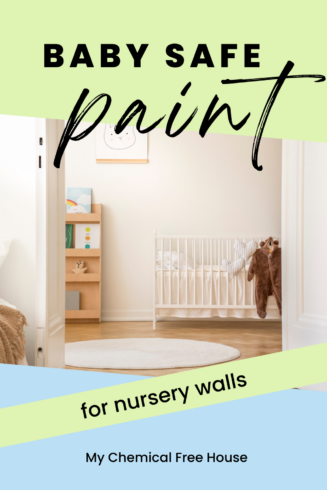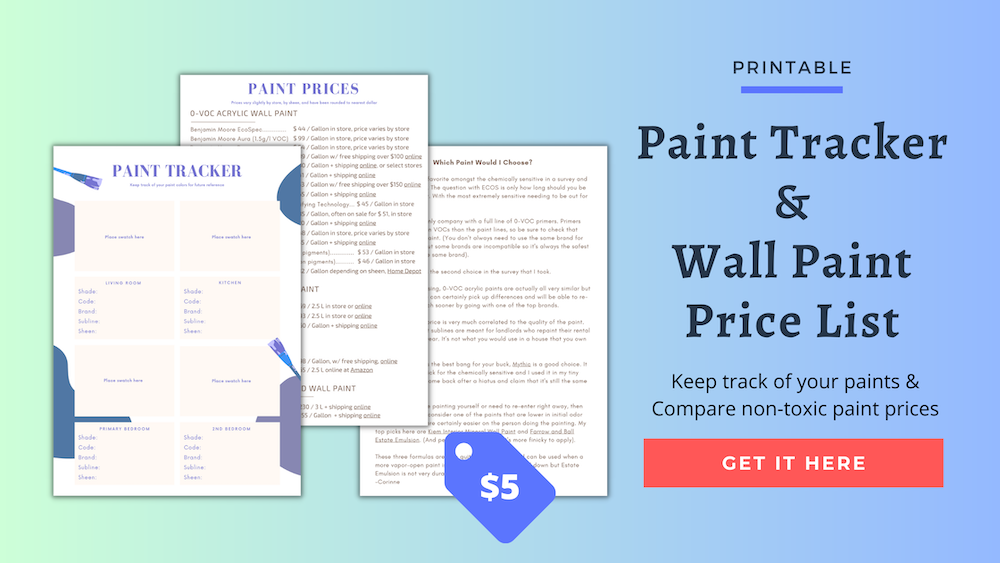Choosing a paint that is safe for a baby is a different task than choosing a paint for chemically sensitive folks, despite a lot of overlap. Babies can’t tell us if they are reacting to a paint or not.
It’s natural to feel worried about which paints are safe for a baby and how long they need to cure before your little one can occupy the room. (Especially since so many companies have been dishonest in the past).
My approach is to start with the best paints out there, these are zero-VOC when possible, and some are natural and emit no synthetic chemical emissions.
They have all been vetted by chemically sensitive folks and tested by me.
I then talked to the companies to ask them how long you should wait before your baby sleeps in the room, and if known, when does it stop offgassing completely.
A paint doesn’t need to be at zero emissions necessarily for someone to occupy the room, since the background air both indoor and outdoor is never at zero VOC, but it’s ideal (and simpler) if it is.
This article contains affiliate links, upon purchase I make a small commission at not extra cost to you.

Non-Toxic Wall Paint for Nurseries
1. ECOS Paint
ECOS Paint is my top pick for wall paint for a nursery. The favorite brand among the chemically sensitive, this zero-VOC 100% acrylic paint, is high quality and comes in curated colors (the Lullaby line, pictured above) or you can color match to major brands.
When is it Zero-VOC?
This is fast to reach negligible levels of VOCs and one rep said over the phone that it is zero-VOC at 2-4 hours when it’s dry, but for a baby’s room she recommended waiting 24-48 hours for full drying (partly because if the paint is not fully dry and they put wet hands on the wall it could damage it).
However, officially the VOC testing was done at 11 days (per the CDPH 01350 test methodology), and that is when the zero-VOC measurement was taken. Emma Pugliares, Marketing Director, says, it hasn’t officially been tested before that.
This is more straightforward than any other brand, especially since we have a clear time at which it was tested at zero VOC.
Chalkboard Paint
They also offer a line of zero-VOC chalkboard paints which would be fun to use in a nursery or kids’ room!
Zero-VOC Primers
ECOS Paints also makes a range of zero-VOC primers. They have the largest selection of zero-VOC primers on the market.
Buy ECOS Paints Online!
Another 0-VOC Acrylic Paint – Benjamin Moore
You can go with other zero-VOC acrylic lines like those from Benjamin Moore.
This is my top pick for a brand you can buy in stores, almost everywhere.
“After seven days, off-gassing is reduced to a minimal or acceptable level according to the California Department of Public Health, which both Eco Spec and Ben (0 VOC lines) are tested against” says rep David Underwood, Associate Technical Project Manager at Benjamin Moore.
Non-Acrylic Wall Paints
1. Kiem Mineral Wall Paint
Kiem Mineral Wall Paint has just a tad of acrylic, the main binder is a silicate mineral which is very benign (and odorless) making this paint lower in fumes when wet compared to 100% acrylic paints.
There is no off-gassing after the paint has dried – in approximately 2 hours at 77 degrees and 50% relative humidity, explains Roy Suttles a rep for the company. He advises waiting 2-4 hours after painting to be sure the paint is completely dried through before you or your baby occupies the room.
This doesn’t require a primer in most situations.
Buy Kiem Mineral Wall Paint through Green Design Center.
2. Farrow and Ball Estate Emulsion (non-acrylic latex)
Farrow and Ball Estate Emulsion is another non-acrylic paint, which uses a VAE (vinyl acetate ethylene) binder instead. Like Kiem, it’s also lower in fumes when wet compared to acrylics. (These two paints are certainly friendlier to the painter).
The VOCs when wet are only 4 g/l and at 28 days the emissions are 47 µg/m3. In terms of when a baby can occupy the room, the company rep suggested waiting overnight. The offgassing can be assisted by opening doors and windows during drying.
For reference, GreenGuard Gold allows – 220 μg/m3 total VOCs. The average house has a total VOC level of about 200 μg/m3, and the outdoor or “background level” is about 1/10th of that (20 μg/m3).
Estate Emulsion is not super durable to sticky hands or to being wiped down, however! The Estate Eggshell is another subline that is acrylic-free.
Buy Farrow and Ball through their website or in-store.
Painting While Pregnant?
The American Pregnancy Association says that “Unfortunately, there are no studies that document the effects of household painting on pregnancy and the developing baby…. Ideally, you should get someone else to do the job for you.”
They also give some precautions for painting while pregnant if you do choose to paint.
Two additional ways to decrease your exposure to VOCs while painting are to choose one of these three non-acrylic paints and to wear a half-face respirator with a multi-gas filter for any synthetic paint.
3. Milk Paint
Milk Paint is all-natural and safe to use even for pregnant women or if babies are in the room (though be very cautious with the dust when mixing it).
However, it’s both difficult to apply to drywall and should have a sealer on top of it. If you do want to use this on walls, use the SafePaint formula which is made for this purpose. I have tried SafePaint and regular Milk Paint (see my results here) and the former certainly worked better and went on more evenly.
Sealers for over top include clear synthetic options and natural oils, they are listed here.

Non-Toxic Trim & Door Paint for Nurseries
A tougher finish is needed for trim and doors, and these are not usually zero-VOC so we have to choose this paint carefully. You can also use these options on wainscoting and other wall detailing.
1. ECOS Semi-Gloss
You can use ECOS or another 100% acrylic paint on trim and doors in a semi-gloss sheen. This is the least durable option for these areas, but not an uncommon one, especially amongst those avoiding toxins.
All of their primers are also zero-VOC so you can prime over wood, MDF, or most previous paint jobs with no issues. (Most brands don’t have all zero-VOC primers).
Buy ECOS online here.
2. Natural Linseed Oil Paint
Natural Linseed Oil Paint is a durable option for trim and doors. This all-natural paint is made with only linseed oil and natural pigments. There is no solvent here and all the odorants are natural.
The only downside of this paint, at least for some people, is that it’s very flat. You also need to make sure your humidity and temperature are within a tighter range than needed for regular paint, or this just won’t cure.
This can go over any type of finish you already have on your trim and doors (except waxes).
Allback and Earth+Flax are two brands available in North America through their websites.
3. Water-Based Alkyd Paints
Benjamin Moore Advance (48 g/l when wet) is a durable water-based alkyd paint.
Water-based alkyds are a relatively new type of paint that can replace much more toxic oil-based (solvent-based) paints while still providing that same durability. Alkyd paints are the conventional choice for trim and doors.
A rep for Benjamin Moore said on the phone that it takes 2-3 weeks for a full cure and to finish offgassing. It also says on the website that depending on the temperature and humidity, it could take up to 30 days to reach optimum hardness and final sheen.
Another water-based alkyd paint is Sherwin-Williams ProClassic Interior Waterbased Acrylic-Alkyd. This comes in at 14 g/l VOC. Give it 2-4 weeks for a full cure, which is when it’s offgassed, they say on the phone.
Buy Benjamin Moore and Sherwin-Williams paints through their stores or online.
Save it to Pinterest!

Have you considered?
Sealing in the formaldehyde from particleboard, MDF, or HDF? This post goes over how to do that.
Wallpaper is also a good option for a baby’s room. I would go with non-PVC peel-and-stick or a non-toxic paper-based wallpaper, both types and brands are outlined here.
Painting a floor in a baby’s room? You can use Milk Paint with a durable oil sealer on top, ECOS Floor Paint, or AFM Concrete Floor Paint. More details in this post.
Painting toys? Use a certified Toy Safe Paint to make sure it’s not leaching metals. Some colors of Milk Paint with a natural oil sealer work well, ECOS Paint is Toy Safe, and there are more options here.

Corinne Segura holds certificates in Building Biology, Healthier Materials and Sustainable Buildings, and more. She has 10 years of experience helping others create healthy homes.
Jamie
Are there any chalk paints you can suggest? We live in a camper and chalk paint would be best for our cabinets. Thank you!
Corinne Segura, Building Biologist
annie sloan
Nicole
Are there any wherein Williams you would recommend? That is what our contractor would like to use…
Corinne Segura
Yes I have an article reviewing the sherwin williams paints, a lot of the lines have extra antimicrobials which Im not a fan of but some dont. also i didnt talk to them to see when it hits 0-VOC so you’d have to ask that
Courtney Cloud
Hi,
Thank you so much for your work!
I am installing a natural fiber grasscloth wallpaper. The installer wants to prime the wall first- with whatever the standard “wallpaper primer” is. She admitted it has a strong odor so I am looking for an alternative.
Would the ECOS universal primer work? I can’t find anything on their website about using specifically for wallpaper. Is there another brand that makes a wallpaper primer specifically?
Appreciate your input/product recommendation!
Corinne
there are 0 VOC wallpaper primers or you might be able to use ECOS semi gloss, if they approve that.
Ana
Thanks for this article. What are your thoughts on Clare?
Corinne
Clare is a pretty standard 0 VOC acrylic paint, with partial ingredient disclosure. I have not sampled it myself and I did not ask them for comment on when it reaches 0 VOC.